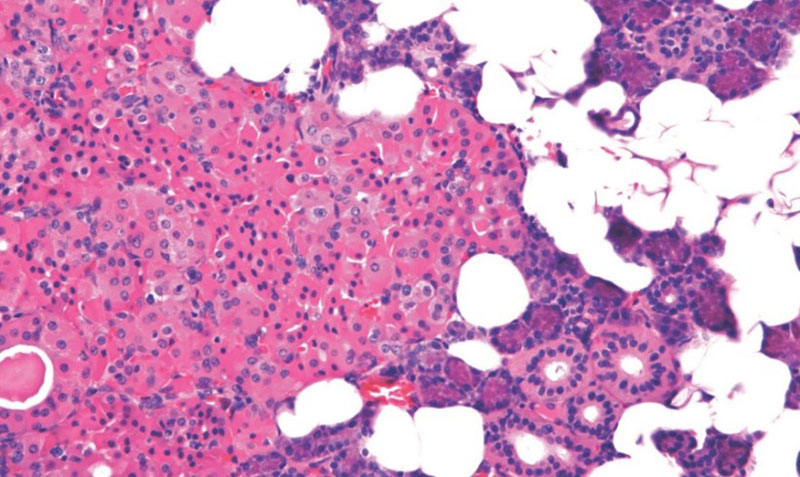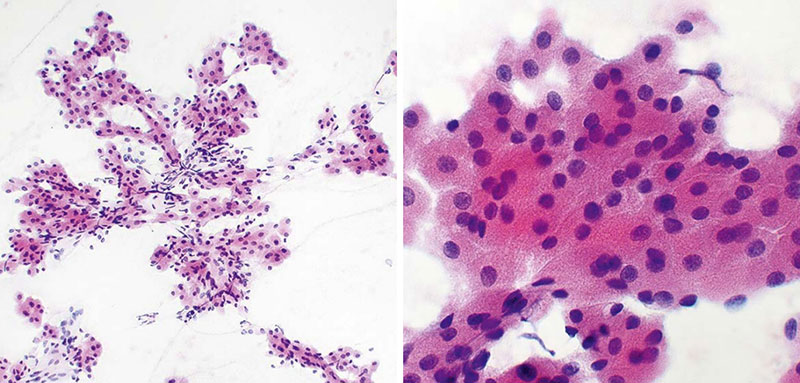Resident Program - Case of the Month
September 2023 – Presented by Jiejun Wu (Mentored by Chihong Heidi Zhou)
Discussion
The correct answer is C and the diagnosis is most likely oncocytosis based on the clinical and FNA findings. In this case, representative cells from FNA show mixed clusters of acinar cells and oncocytes (Figure 1, left). The oncocytes have eosinophilic cytoplasm with fine granules (accumulated mitochondria) and uniform nuclei without noted nucleoli (Figure 1, right bottom). In addition, these cells are mass forming per the findings from ultrasound, which differentiate oncocytosis from oncocytic metaplasia (choice B) which usually not mass-forming.
The oncocytic changes or lesions in salivary glands form a spectrum, from reactive changes to malignancy, including non-mass forming reactive oncocytic metaplasia, nodular oncocytic hyperplasia also called oncocytosis, benign entities including oncocytoma and Warthin’s tumor, and malignant tumors such as oncocytic carcinoma. The focus of this discussion is primarily on morphology since ancillary tests such as immunostaining do not offer much help with differential diagnosis of these discussed entities. Oncocytic metaplasia are clusters of acinar cells with oncocytic changes, a natural process with aging. Oncocytosis (oncocytic hyperplasia) could form variably sized nodules or diffusely involved all the salivary glands. Since there is intimate association between oncocytes and normal salivary gland parenchyma (Figure 2), FNA specimen can show admixed clusters of oncocytic and acinar cells as shown in this case.
 Figure 2. Oncocytosis with sheets of oncocytes (left) showing an intimate association with the salivary gland parenchyma. (Adapted from reference 2, p273)
Figure 2. Oncocytosis with sheets of oncocytes (left) showing an intimate association with the salivary gland parenchyma. (Adapted from reference 2, p273)
The differences between oncocytosis and oncocytoma (Choice D) could be vague; the features favoring oncocytoma, the benign and proliferating form of oncocytic lesion, include partial or full encapsulation and lack of included ductal structures. Aspirates of oncocytoma are more cellular and present as sheets, cords or loose clusters (Figure 3) without admixing acinar cells. Another more frequently encountered oncocytic lesion is Warthin’s tumor (Choice E) which often has lymphocytic component and cystic background to help differentiate it from other benign oncocytic lesions. Oncocytic carcinoma (Choice F) is rare and often challenging to diagnose though marked malignant features of cytologic atypia, mitotic figures, necrosis, lack of capsule, vascular and/or perineural invasion could be morphologically helpful. Other monomorphic oncocytic neoplasms, including oncocytic cystadenoma, mucoepidermoid carcinoma, acinic cell carcinoma, breast analogue secretory carcinoma and metastatic renal cell carcinoma, though not discussed in depth here, should also be considered in differential diagnosis.
 Figure 3. Oncocytoma showing branching cords of proliferating oncocytes. (Adapted from reference 3, p352)
Figure 3. Oncocytoma showing branching cords of proliferating oncocytes. (Adapted from reference 3, p352)
References
- Schaberg K. "Salivary Gland Tumors" (PDF). accessed on 10/22/2022.
- Richardson MS. Benign neoplasms of the salivary glands. In: Thompson LDR and Bishop JA, editors. "Head and neck pathology: a volume in the series foundations in diagnostic pathology", 3rd, Elsevier, 2019. pp.272-274.
- Krane JF and Faquin WC. "Salivary gland". In: Cibas ES and Ducatman BS, editors. "Cytology: diagnostic principles and clinical correlates", "em>5th, Elsevier, 2021. pp.348-353.
- Özakkoyunlu Hasçiçek S, Tunçel D, et al. "Oncocytic Lesions of Salivary Glands with Morphological and Immunohistochemical Findings". Sisli Etfal Hastan Tip Bul. 2020 Mar 24;54(1):88-93.

 Meet our Residency Program Director
Meet our Residency Program Director
